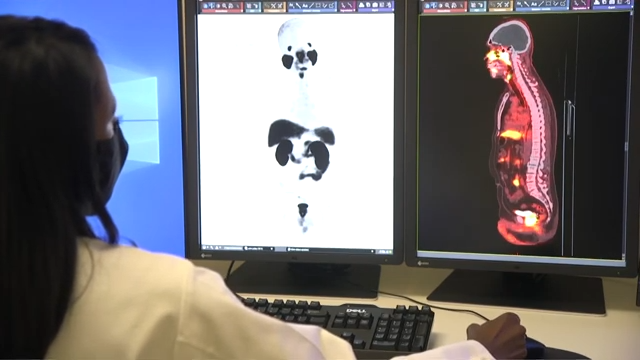CHICAGO. (Ivanhoe Newswire) — Prostate cancer is the second leading cause of cancer death among American men. Patients have several different treatment options, including two types of internal radiation therapy: low-dose rate brachytherapy or high –dose rate brachytherapy. Both involve having radioactive seeds implanted near the tumor. For years, very few patients took advantage of the high-dose option, but that may begin to change.
Sixty-four-year-old Greg Hildebrand didn’t want to be sidelined for long after getting this good news slash bad news message from his doctor.
Hildebrand told Ivanhoe that his doctor said, “Mr. Hildebrand, unfortunately we found cancer but not to worry, this is readily treatable.”
To treat his prostate cancer, Hildebrand went with a procedure called high-dose rate brachytherapy. Unlike the low-dose rate radiation treatment, which permanently implants radioactive seeds directly into the prostate, the high-dose rate radiation is removed the same day.
Abhishek Solanki, M.D. , radiation oncologist at Loyola University Medical Center in Chicago explained, “The radiation is delivered right then and there later that day as opposed to having a permanent source inside you that slowly delivers the radiation over six to eight months.”
Hildebrand received two treatments over two weeks. His side effects lasted only one month. Doctors say complications from the low-dose-rate treatment can last six months.
“It’s cleaner, it’s more direct, it’s less intrusive,” detailed Hildebrand.
HDR was clearly the better option for him, so how come not all doctors have embraced it?
Dr. Solanki told said “One of the reasons why is, from a resource perspective, for the staff and clinic, it’s a little bit harder.”
But for some patients, it may be the key to good health
Dr. Solanki said more doctors are starting to consider high-dose rate radiation brachytherapy as a treatment option now that there are 10-year studies showing it is just as effective as the low-dose rate treatment and the cancer doesn’t return in 80 to 90 percent of patients in a certain risk group. A study by the Cleveland Clinic found that brachytherapy was the cheapest of all treatments for prostate cancer with an average cost of $2,500. Brachytherapy is used only in patients whose cancer has not spread to other organs.
Contributors to this news report include: Cyndy McGrath, Supervising Producer; Jessica Sanchez, Field Producer; Milvionne Chery, Assistant Producer; Tony D’Astoli, Editor and Videographer.
MEDICAL BREAKTHROUGHS
RESEARCH SUMMARY
TOPIC: Prostate Cancer: New Look at an Old Treatment
REPORT: MB #4155
BACKGROUND: Other than skin cancer, prostate cancer is the most common cancer in American men. The American Cancer Society estimates 180,890 new cases of prostate cancer will be diagnosed in 2016. About 1 in 7 men will be diagnosed with prostate cancer during his lifetime. About 1 in 39 men will die of prostate cancer. Although prostate cancer can be a serious disease, most men diagnosed do not die from it. Over 2.9 million men in the United States who have been diagnosed with prostate cancer are still alive today. Prostate cancer begins when cells in the prostate gland start to grow uncontrollably. The prostate is a gland found only in males, therefore, this cancer occurs only in males. Almost all prostate cancers are adenocarcinomas, cancers that develop from the gland cells that create fluid. Most prostate cancers grow slowly. Some men will have prostate cancer for a long time without realizing it.
(Source: http://www.cancer.org/cancer/prostatecancer/detailedguide/prostate-cancer-key-statistics)
TREATMENT: Depending on the situation, the treatment options for men with prostate cancer might include surveillance, surgery, radiation therapy, cryotherapy, hormone therapy, chemotherapy, vaccine treatment, and bone-directed treatment. These treatments are generally used one at a time, although in some cases, they may be combined. Radiation therapy may be used as a first treatment for cancer that is still just in the prostate gland and low grade, as a part of a treatment, or to help keep the cancer under control for as long as possible and to help prevent or relieve symptoms. The two main types of radiation therapy used for prostate cancer are external beam radiation (EBRT), and brachytherapy. In EBRT, beams of radiation are focused on the prostate gland from a machine outside the body. This treatment is typically given 5 days a week over the course of several weeks. Brachytherapy uses small radioactive pellets about the size of a grain of rice which are placed directly into the prostate.
(Source: http://www.cancer.org/cancer/prostatecancer/detailedguide/prostate-cancer-treating-radiation-therapy)
NEW LOOK: When given the options between permanent low dose rate brachytherapy and temporary high dose rate brachytherapy, most choose low dose. In low dose rate permanent brachytherapy, about 100 seeds are left in place and give off low doses of radiation for weeks or months. Temporary high dose rate brachytherapy uses higher doses of radiation that are left in place for a short time. Radioactive iridium-192 or cesium-137 is placed into catheters that are placed in the body for five to 15 minutes. Generally, only three brief treatments are given over two days, with the radioactive substance removed each time. The advantage of this approach is that most of the radiation is concentrated in the prostate itself, sparing nearby normal tissues.
(Source: http://www.cancer.org/cancer/prostatecancer/detailedguide/prostate-cancer-treating-radiation-therapy)
FOR MORE INFORMATION ON THIS REPORT, PLEASE CONTACT:
Jim Ritter
Media Relations
If this story or any other Ivanhoe story has impacted your life or prompted you or someone you know to seek or change treatments, please let us know by contacting Marjorie Bekaert Thomas at mthomas@ivanhoe.com




